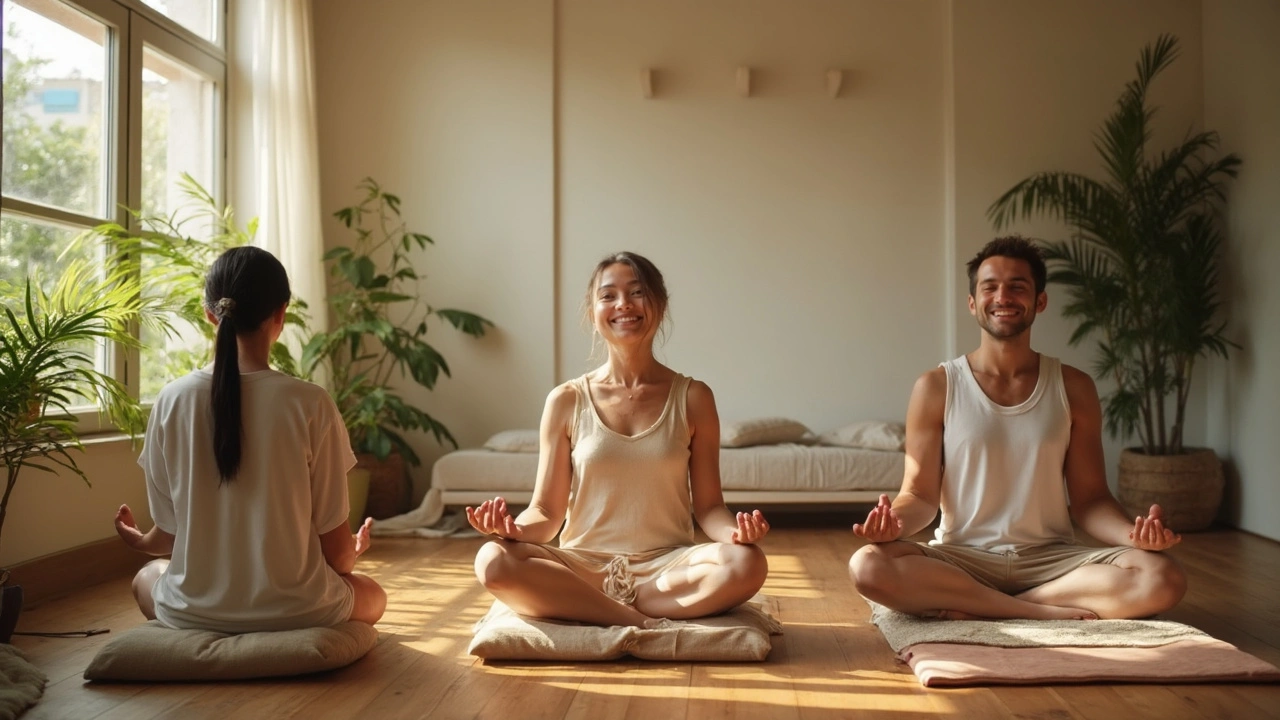Tired of feeling stressed all the time? You’re not alone. Thai massage has gained a loyal following for one big reason—it actually works for both your mind and body. If you’re curious, you’re about to find out what sets it apart from a regular back rub.
People don’t just leave a Thai massage feeling relaxed. They walk out with less soreness, better flexibility, and a calm mind that sticks around long after the session ends. Think of it as a tune-up for your muscles and your mood. The best part? You don’t need to be a wellness fanatic to appreciate the results. Whether you’re sore from sitting at a desk, on your feet all day, or just looking for a mental reset, this could be just what you need.
The beauty of Thai massage is how it blends gentle stretching, pressure, and mindfulness to help you reconnect with yourself. No oils or fancy spa tricks—just skilled hands and movements designed to make you feel balanced and refreshed. Stick around, and you’ll see how simple it can be to start your own journey toward a more relaxed, pain-free you.
- Definition and Context
- Benefits of Thai Massage
- Types and Where to Find Them
- What Happens in a Thai Massage Session
Definition and Context
Thai massage (or "Nuad Thai") isn’t just another spa trend—it goes back over 2,500 years, born out of traditional Thai medicine. The method pulls together yoga-like stretches, acupressure, and deep rhythmic movements. The goal? To ease muscle tension, boost flexibility, and bring your body back into balance. No scented oils or candles involved—you keep your comfy clothes on and relax on a floor mat, not a massage table.
This type of massage stands out because it’s active. You’re gently stretched, twisted, and sometimes even walked on (yes, really). It looks kind of like assisted yoga, where the practitioner uses hands, elbows, knees, or even their feet to help guide your body into different positions. If you hate just lying still, it’s a total game changer.
Why do people keep coming back? In 2019, UNESCO added "Nuad Thai" to its Intangible Cultural Heritage list, which says a lot about how respected and valuable this practice is in Thailand and around the world.
If you’re wondering what’s so special, it’s the way Thai massage mixes physical therapy with mindfulness. Instead of zoning out, you’re encouraged to breathe deeply and stay present in the moment. It’s not just about stress relief—it’s about rewiring your body and mind for real, long-term benefits.
| Thai Massage | Regular Western Massage |
|---|---|
| Clients stay fully clothed | Clients usually undress |
| Uses pressing, stretching, and rocking motions | Focuses on kneading and rubbing |
| No oils or lotions | Often uses oils and lotions |
| Done on a mat on the floor | Done on a massage table |
To sum it up, thai massage is way more than just a way to chill out. It’s recognized around the world for helping people find both physical comfort and mental clarity. It’s low-tech, but the results can feel pretty amazing.
Benefits of Thai Massage
When it comes to feeling better, Thai massage offers more than just a quick fix for tight shoulders. Let’s get real about how this hands-on therapy can make a difference in your everyday life.
First off, here are the main perks you can expect from Thai massage:
- Improved flexibility and joint movement—think of it as assisted stretching, great for anyone who spends long hours at a desk or does a lot of physical work.
- Reduced muscle tension and pain—the pressure techniques work out those stubborn knots, especially where stress tends to build up.
- Better circulation—many fans say they notice less swelling and warmer hands and feet after regular sessions.
- Mental relaxation—it’s not unusual to leave a session feeling like you just hit the reset button on your mood.
- Boosted energy—because it combines movement and mindful breathing, you often walk out feeling more awake, not sleepy.
Here’s something a lot of people miss: Thai massage isn’t just about the body—many people report that their sleep improves afterwards, and some even see better focus at work. A survey by the Thai Ministry of Public Health (2019) showed that 72% of regular Thai massage users reported less frequent headaches and less back pain. That’s nothing to sneeze at!
| Benefit | What You Might Notice |
|---|---|
| Flexibility | Looser hips and shoulders, easier to bend or twist |
| Muscle Relief | Less soreness, can lift or carry with less effort |
| Mood Boost | More upbeat, less stressed during tough days |
| Sleep Quality | Falling asleep faster, sleeping more deeply |
| Energy | Less afternoon tiredness, more get-up-and-go |
Another interesting fact: Thai massage is sometimes called “lazy yoga” because the therapist does most of the moving and stretching for you. This means you get yoga-like results without working up a sweat. If you’re new to massage or have trouble stretching on your own, this can be a game-changer.
All in all, a thai massage session can help you feel more comfortable in your own skin—physically and mentally. It’s a simple but powerful way to get back to your best self, one session at a time.

Types and Where to Find Them
Thai massage isn't just one thing—there are several types, and each brings a unique vibe. Most people start with traditional Thai massage, which mixes stretching, pressure, and rocking moves. This style usually happens on a mat on the floor. Don’t expect oil or fancy lotions. The therapist moves your body through stretches while pressing and kneading key muscle points. It looks a bit like partnered yoga, but way more relaxing.
Next, there’s Thai oil massage, which takes some moves from Swedish massage and mixes them with Thai techniques. This style is great if you want something more straightforward, with smooth strokes and a little less stretching. Aromatherapy options, which use essential oils, can help if you want an extra calming effect.
If you’re more into foot care, Thai foot massage uses pressure points along your feet and lower legs. Reflexology fans swear by it for a good night’s sleep or a burst of midday energy. Some places even offer targeted massages, like Thai herbal compress massage, where warm herbal bundles get pressed into your skin to help with pain or tight muscles.
- Traditional Thai Massage: Focuses on full-body stretching and pressure, done on a floor mat.
- Thai Oil Massage: Combines relaxing, gentle strokes with less intense stretching.
- Thai Foot Massage: Focuses on pressure points in the feet and calves, often for boosting energy or relaxing after long days on your feet.
- Herbal Compress Massage: Uses warm herbal pouches to ease soreness and muscle stiffness.
Finding a good Thai massage spot isn’t hard, but picking the right one will make all the difference. In most big cities, you’ll spot authentic Thai massage studios, fusion wellness centers, and high-end spas. Look for businesses with certified therapists—many should display their credentials or be upfront about their training. Chain studios can be a safe bet for consistency, while local independent studios sometimes have a more personal vibe.
If you live in the US, cities like Los Angeles, New York, and Houston have dozens of highly rated massage parlors. Thailand itself is the go-to place for everything Thai massage, especially in Bangkok and Chiang Mai. In Europe, London and Berlin are known hubs for proper Thai massage treatments.
| Type | Main Features | Where You’ll Find It |
|---|---|---|
| Traditional Thai | Full-body, stretches, acupressure, floor mat | Thai massage studios, wellness centers |
| Oil Thai | Gentle strokes, some stretching, scented oils | Spas, fusion clinics |
| Foot Thai | Reflexology, foot pressure points | Massage parlors, airports, malls |
| Herbal Compress | Warm herbal pouches, pain relief | High-end spas, traditional clinics |
When searching online, try phrases like “Thai massage near me” or "certified Thai massage therapist." Reading reviews on Google or Yelp can tell you a lot about cleanliness, professionalism, and user satisfaction. If you’re traveling in Thailand, nearly every urban block will have options—just check for businesses with lots of local customers. That’s usually a great sign.
What Happens in a Thai Massage Session
Walking into a Thai massage session, you might notice it’s not your typical spa scene. Don’t expect fancy oils or a quiet room with just light piano music. Instead, you’ll likely get handed loose, comfy clothes to change into. Forget nudity or feeling exposed—this is all done fully clothed on a padded mat on the floor, not on a massage table.
At the start, your therapist might ask a few questions about where you feel sore or tense, any old injuries, and your comfort level with pressure. This helps them make the session work for you. And don’t worry, if anything feels off during the massage, just let them know—they’ll easily change it up.
- Stretching is a big part of Thai massage. The therapist uses their hands, elbows, knees, and even feet to gently guide your body into different stretches. It’s a bit like yoga, but you don’t have to do any work—they do it for you.
- Rhythmic pressure: Expect the therapist to press, rock, and knead muscles along lines called “Sen” (think of these as energy highways). This can sound intense, but it’s surprisingly relaxing once you get used to the flow.
- Flow and movement: Sessions move from your feet up to your head (or the other way around), targeting trouble spots and boosting overall flexibility. If you’re tight from working out or just sitting all day, you’ll definitely notice a difference at the end.
If you like numbers, a typical session lasts 60 to 90 minutes. Some places offer quick 30-minute options, but most people go for at least an hour to really feel the benefits. Here’s a simple look at what’s common:
| Session Length | What You Get |
|---|---|
| 30 minutes | Quick spot treatment (neck, back, or legs) |
| 60 minutes | Full-body basics (general stretches and muscle relief) |
| 90 minutes | Head-to-toe deep stretches, pressure points, and serious relaxation |
If you’re wondering about soreness, most people feel looser right away, but a little muscle ache (like after a good workout) isn’t unusual. Drinking water and taking it easy after your session helps a lot. If you’re new to Thai massage, start with light to moderate pressure and let your therapist know how you’re feeling throughout. That way, you get the most from your thai massage experience without any surprises.



